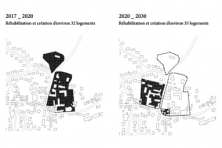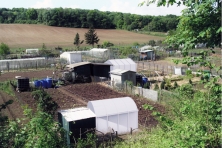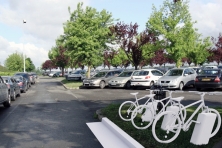Par la grande porte
Fosses (FR) – Runner-up
TEAM DATA
Team Representative: Hans Lefevre (FR) – architect; Associates: Matthieu Bergeret (FR), Paul Rolland (FR), Julien Rouger (FR) – architects; Flavien Bézy (FR) – urban planner
Hans Lefevre, 2:pm architectures, 14 rue Lauzin, 75019 Paris – France
+33 9 54 31 98 44 – contact@2pma.com – www.2pmarchitectures.com
See the complete listing of portraits here
See the site page here
 J. Rouger, P. Rolland, F. Bézy, H. Lefevre and M. Bergeret
J. Rouger, P. Rolland, F. Bézy, H. Lefevre and M. Bergeret
INTERVIEW
1. How did you form the team for the competition?
Two years ago we created a variable geometry collective to work on urban strategies: BAU - Office of Urban amenities. Under this entity we participated to Europan 12, Europan 11 and the Neuchatel 2020 (CH) international competition, which we won. We also work together for the current urban planning operation (ZAC des Collinettes) taking place in Seine-et-Marne department (FR).
2. How do you define the main issue of your project, insisting on how you answered on this session main topic: adaptability and urban rhythms?
Adaptability to urban rhythms is for us a central issue for city planning. We are indeed targeting small sewing strategy adapted to what is already there to suit with the land identity of the spaces we work on. It is definitely about forgetting the great urban intervention – the "concept" is more looking for a work of local surgery to fit with the existing context, as a territory graft.


3. How did this issue and the questions raised by the site mutation meet?
It was more a synergy between those issues. The natural urban transformations are necessary for urban areas to fit with time. Adaptability and urban rhythms are the backbone of urban renewal. It is thinking places, customs, new environments in a functional flow within identity and structuring what is already there. In this specific case we developed a type of urban planning of progressivity and reversibility, where the town morphological heterogeneity is taken as a force for which we must strive to formal sobriety, seeking intense resident situations, real, strong and claimed coinhabitants situations.



4. Have you already treated this issue previously and could you present some reference projects that inspired yours?
We have already experimented this concept in a competition in Switzerland, named Neuchâtel 2020, in which issues were to propose, as urban acupuncture, an inventory of places with real mutation capacities within the existing urban fabric in use rather than expand the Neuchâtel urban footprint.
5. Today –within the era of an economic crisis and sustainability– the urban-architectural project should reconsider its production method in time; how did you integrate this issue in your project?
We must indeed rethink the methods of manufacturing the city. But the economic crisis is not the only reason that determines the need for this new way of making the city. Today, the population should appropriate the project and that is why the people must get involved in urban planning, get involved to take ownership. Time is and shall allow seeing the birth of a new heritage. Heritage not in the sense of old stones but as a cultural and contextual common identity.
6. Is it the first time you have been awarded a prize at Europan? How could this help you in your professional career?
Actually, it is the second time we have won Europan (Runner Up E11 in Aigle, Switzerland). Europan offers a beautiful European visibility and especially provides the opportunity to see projects be implemented (when the cities are involved – and this should be a commitment).